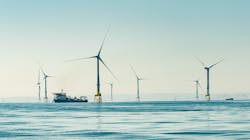Offshore electric vessel charging station gets UK government funding
Offshore staff
BANCHORY, UK — A two-year project to develop an offshore charging station for offshore wind farm vessel operations has secured funding under Britain’s Department for Transport and Innovate UK’s Clean Maritime Demonstration Competition.
Marine charging specialist Oasis Marine is leading the program, in partnership with power electronics/charging provider Turbo Power Systems and Verlume, which provides intelligent energy management and storage technologies.
Also involved is the Offshore Renewable Energy (ORE) Catapult, a technology innovation and research center in the UK for offshore renewable energy. The planned energy storage and charging infrastructure will be designed to enable fully electric maritime operations within offshore wind farms.
In the second phase, the partners will work with wind farm developer Vattenfall on technical and regulatory developments, with a view to an on-turbine demonstration at the latter’s European Offshore Wind Deployment Centre in Aberdeen Bay.
Turbo Power Systems’ high-power charging system will take AC power generated by existing wind farms to the power buoy. During the demonstration, a hybrid CTV would operate between Aberdeen Harbour and the wind farm, then connecting to and recharging from the power buoy while waiting as maintenance technicians work on the turbines.
According to Oasis Marine, electric and hybrid vessels can currently be charged only within ports, and most offshore wind farms are too far from shore to allow full journeys on battery power. The new service, however, would allow CTVs to operate mostly on electric power, extending their operational range.
The power buoy underwent initial sea trials early last year, and the new funding will allow for full infrastructure tests.
ORE Catapult will be responsible for CTV requirements, supporting a regulatory review and project management.
Although CTVs will be the primary focus, the concept could be scaled for oil and gas vessels and larger service operations vessel daughter crafts, which could feature increasingly as wind farm developments move farther out at sea.
02.16.2023

